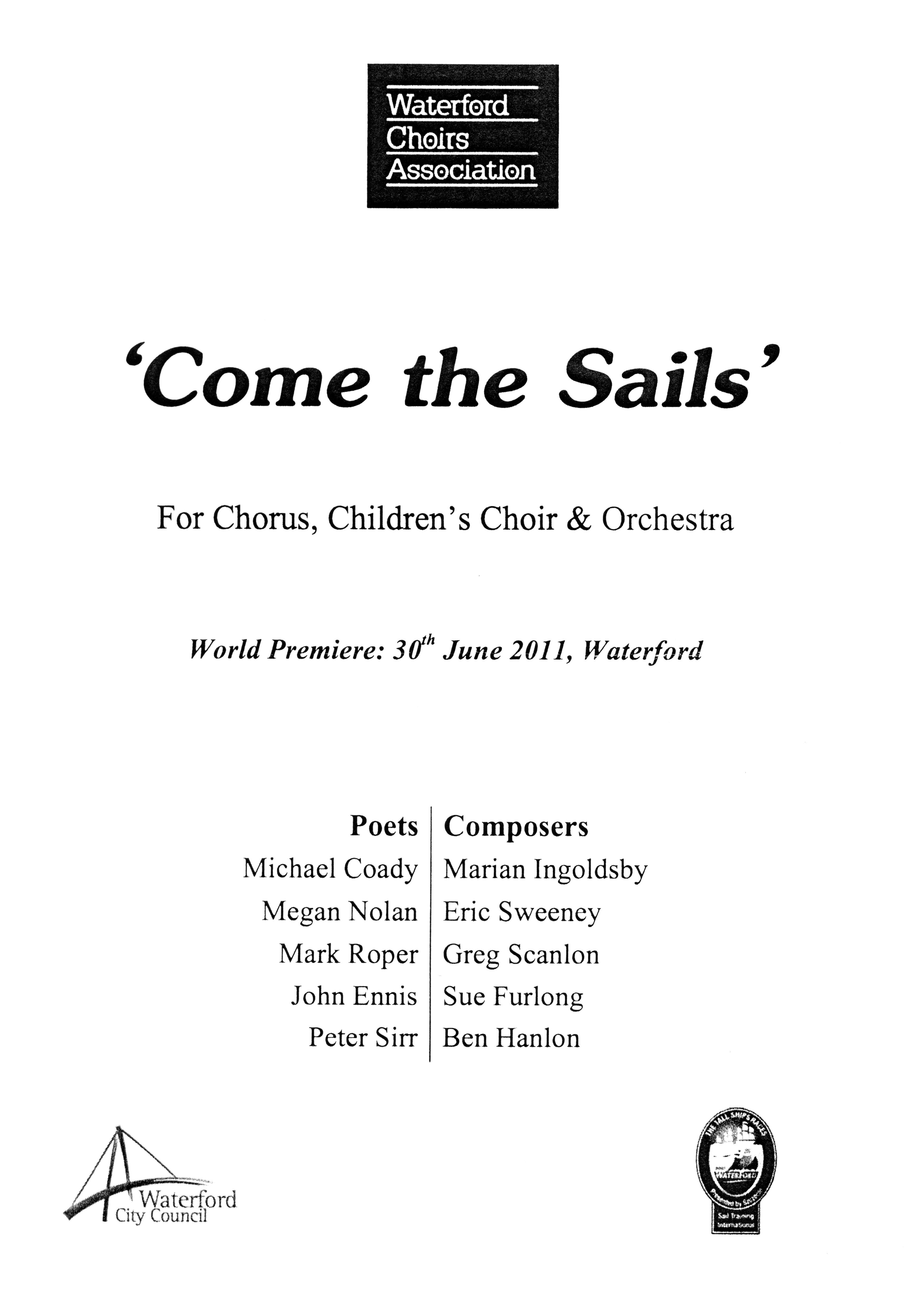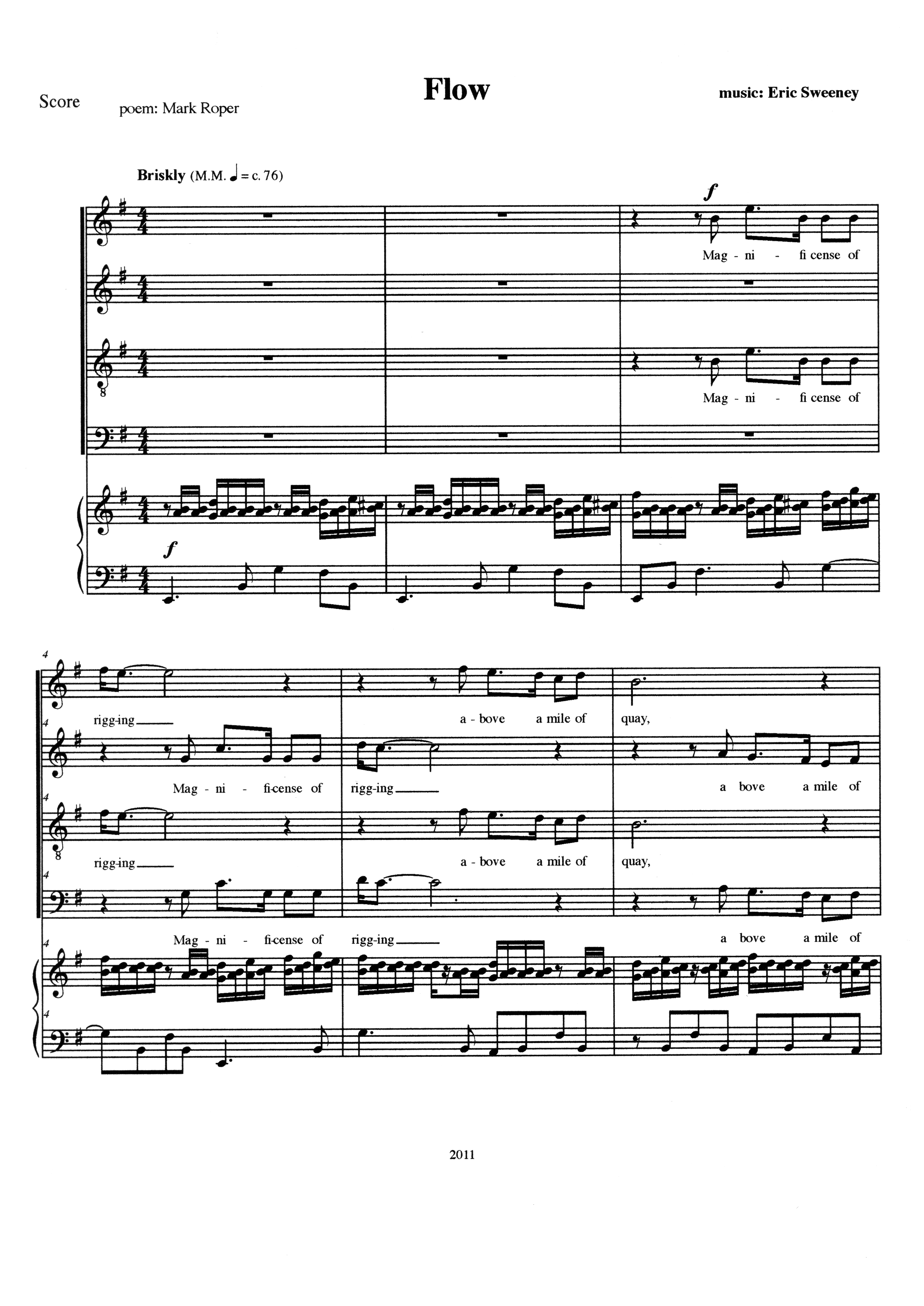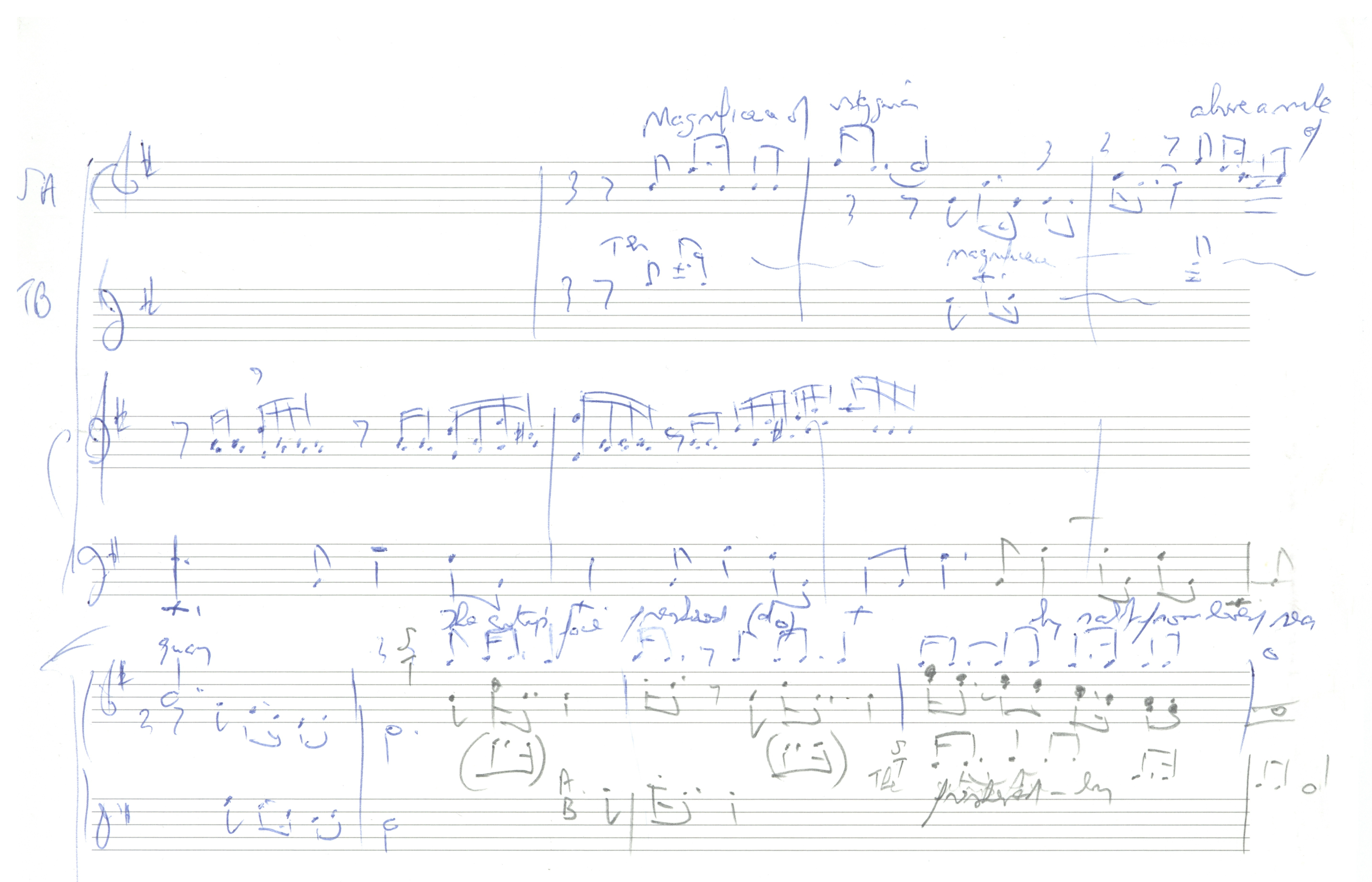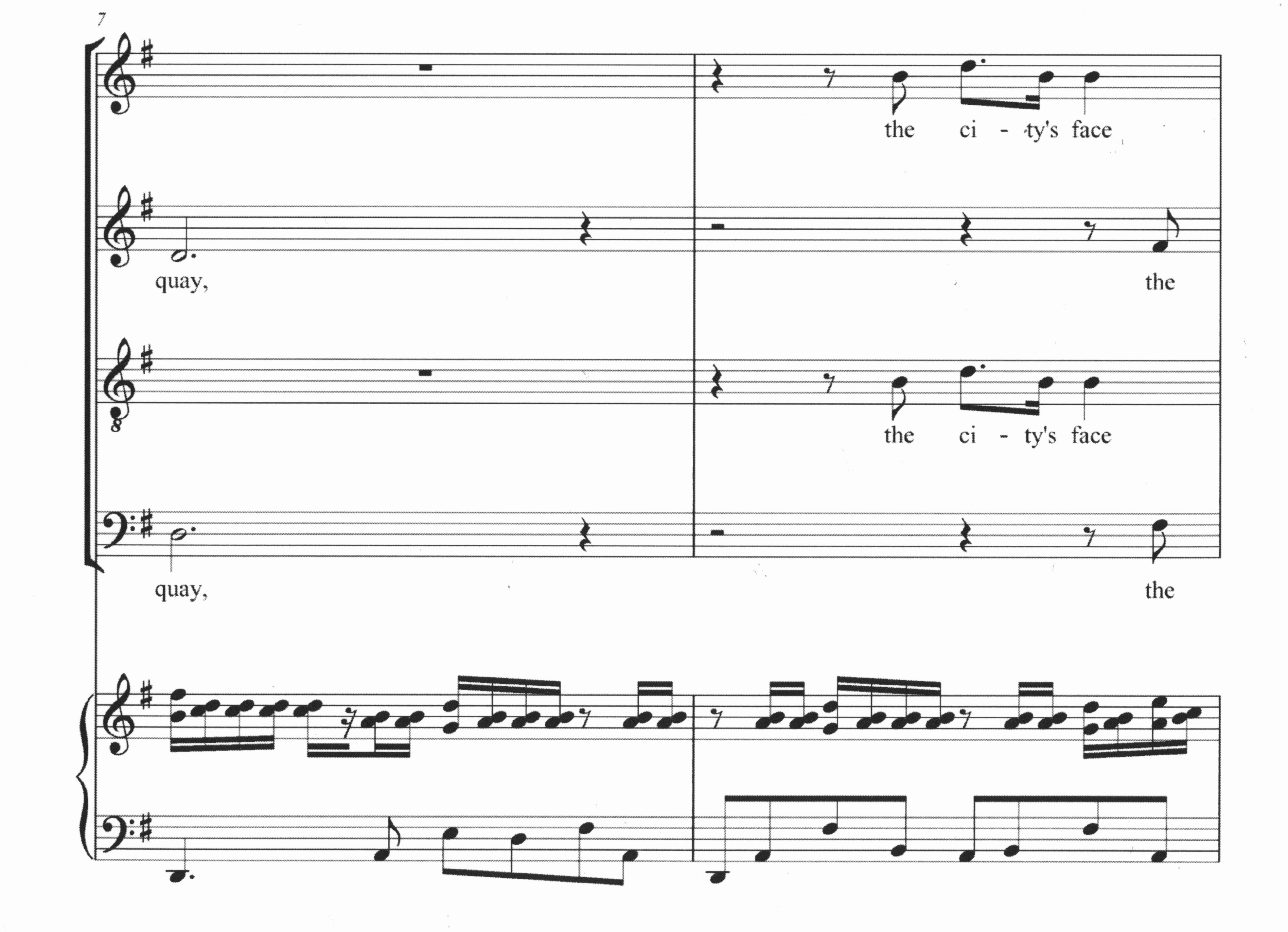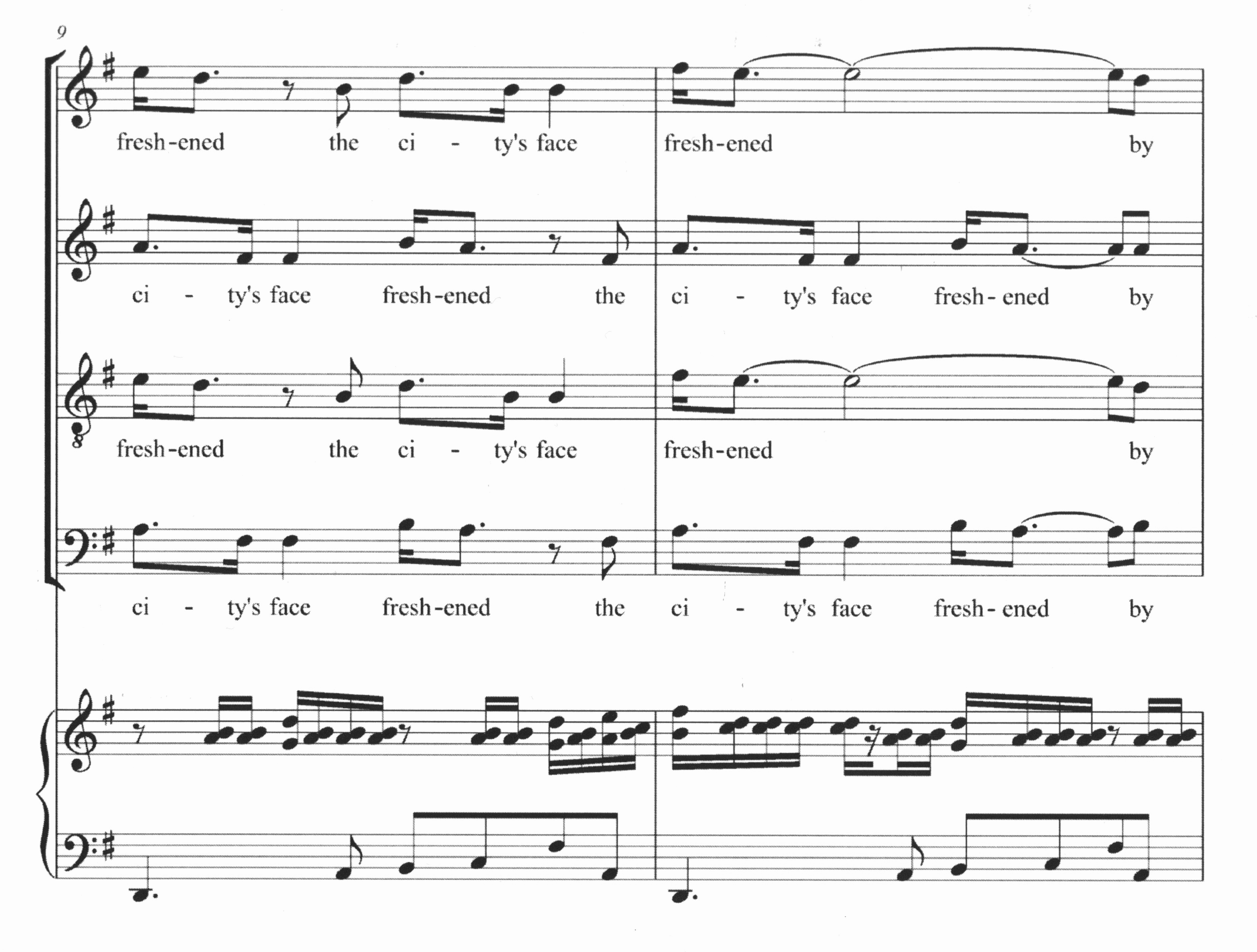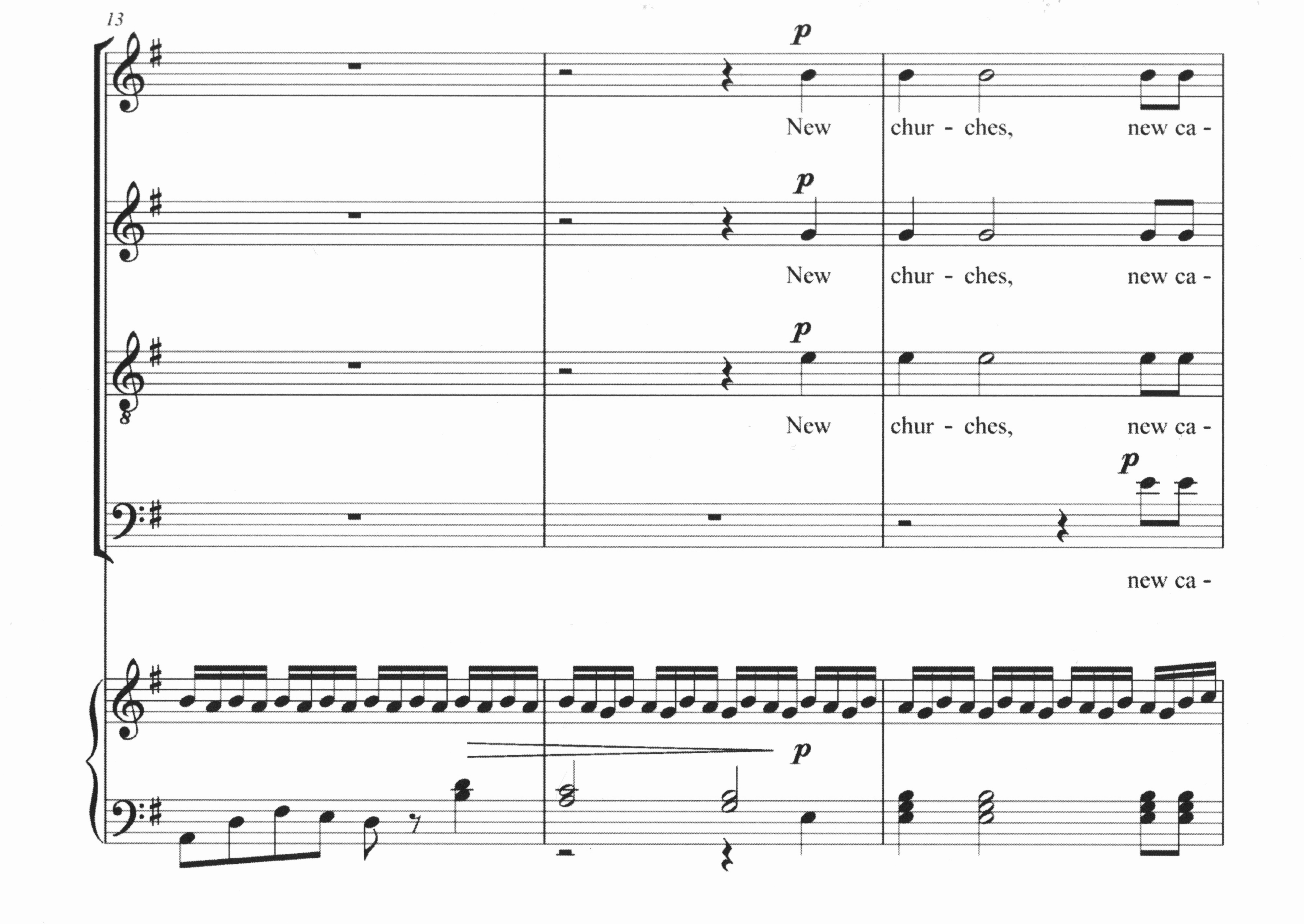Digitising Eric Sweeney's 'Flow: A Prosperous Port'
Claire Warburton, an MA Performance and Musicology student at Maynooth University, recently completed her digital skills placement at CMC. Her work involved the digitisation of Eric Sweeney's 'Flow: A Prosperous Port' and programme notes. The following article details Claire's research accompanied by some of the digitised material.
During my five week placement with the Contemporary Music Centre, I had the opportunity to explore the late Eric Sweeney’s choral composition 'A Prosperous Port', contributing to the archiving of this work through the digitisation process. Drawing on the rich resources of the CMC helps to contextualise Sweeney’s significant musical output, while framing this work within Sweeney’s compositional style paves the way for an appreciation of the remarkable cultural and historical links in 'A Prosperous Port', and how Sweeney fosters a sense of place in the music. Evaluating programme notes from the premiere, Sweeney’s original handwritten sketch for the piece, and a working and official score, enables us to piece together a story regarding this incredible work with strong historical links to Waterford City. Ultimately, the availability of this range of materials and the value of digitising them helps to understand the development not only of the work, but of the composer’s creative process.
Eric Sweeney (1948-2020) was an eminent and prolific contributor to music in Ireland whose notable compositional output included two symphonies, five concertos, three operas and various choral works. Sweeney studied music at Trinity College Dublin, graduating in 1969 and pursued organ studies in Belgium and at the Conservatorio di Musica Santa Cecilia in Rome. According to The Irish Times, from 1978-1981 he was choral director of the RTÉ Singers while also lecturing in music at TCD, after which in 1981 he moved with his family to Waterford to accept the post of Head of Music at the Waterford Institute of Technology (WIT), building the music department there into ‘a vibrant hub of creativity and new music’ for thirty years. As a composer, organist, conductor, respected educator and lecturer in contemporary music, Sweeney was one of the first Irish composers to embrace a minimalist style.
An interesting starting point in exploring Eric Sweeney’s work is the CMC’s valuable Amplify Podcast No. 25 recorded in September 2020 dedicated to Sweeney, his music, and his notable contribution to music in Ireland. In this podcast, John Buckley spoke of Sweeney and his significant and sustained contribution to the musical and broader cultural landscape of Ireland. While a variety of Sweeney’s works can be accessed on the CMC website, it is his choral work for SATB and piano entitled 'A Prosperous Port' that is particularly intriguing to research, as it not only encompasses Sweeney’s multi-faceted contribution to the musical, cultural and historical context of Ireland, but it is one of his pieces that is now a new addition to the CMC library through this digitisation project.
Sweeney’s choral composition ‘A Prosperous Port’, with poetry by Mark Roper was part of a new choral work commissioned by Waterford Choirs Association for the city, intertwining themes from ‘the profound relationship between the River Suir and the history of Waterford City’. Commissioned to celebrate the rich maritime history of Waterford and in particular the visit of The Tall Ships in 2011, the premiere of the work entitled ‘Come the Sails’ encompassed four choral works interlinked by a fifth instrumental piece with accompanying spoken dialogue. Uniquely, this commission and premiere combined the collaboration of five composers with five poets from Waterford or with strong connections to Waterford for each section of the work. Ultimately, the programme notes from the event advocated that ‘Come the Sails’ was ‘a new work of art by and for Waterford’.
Programme cover from the world premiere of ‘Come the Sails’ in 2011, Waterford
Reflecting on the CMC’s Through the Digital Door feature, which offers valuable insight into Sweeney’s approach to composition and evolution of musical style, it is fascinating to briefly mention the roots of Sweeney’s philosophy for choral composition. While Sweeney’s compositional style was influenced by composers such as Bartók, Stravinsky and Messiaen with his later piano and instrumental works encompassing a fusion of minimalism with elements of Irish traditional music, it is through the focus on his choral music that interesting insights emerge. According to The Irish Times, Sweeney’s vocal and choral music was guided by Italian composer Claudio Monteverdi’s mantra ‘text first’ with the words shaping and determining the rhythm and style of the musical compositions. Particularly relevant to this piece, Sweeney interestingly discusses this Monteverdian influence in a documentary filmed about the work ‘Come the Sails’ in which we get a glimpse of a brief section of the performance of ‘A Prosperous Port’ (7.25 – 10.05).
Although finding no definitive links to another ‘text first’ genre among Sweeney’s discussions about his work, that of sean-nós singing, given his passion for Irish traditional music and frequent implementation of fragments of Irish melodies and airs in his work, it would be an interesting analytical avenue to explore if perhaps Sweeney did take inspiration from this genre for his vocal compositions. However, what is clear from an interview with John Hughes about his life and music from the CMC sound archive, was the influence of Sweeney’s formative years as a choirboy and how this significant start and wonderful historical repertoire of choral works left a great mark on Sweeney’s music.
Although showcased at the Waterford quayside with massed choir and orchestra, this discussion of 'A Prosperous Port' will focus on the scores for SATB choir and piano. When evaluating all the material CMC now have on this particular piece, there is an interesting element regarding the change of title that was possibly altered to be more aligned with the thematic approach of the work and its association with the Waterford Tall Ships Event. In Sweeney’s original score, the title he had penned for the piece was ‘Flow’. While both scores are almost identical with the same tempo marking, key and time signature, the final score in the event booklet with the title ‘A Prosperous Port’ is more refined in its finish with dynamic markings on all parts when they enter. While ‘Flow’ still retains a connection with the maritime imagery associated with Waterford, the title of ‘A Prosperous Port’ is undoubtedly more apt for the occasion and composition.
First page of Sweeney’s score ‘Flow’ and the published ‘A Prosperous Port’ score from the world premiere booklet
However, what is also invaluable to have is a section of Sweeney’s original handwritten score as it allows us to trace the evolution from his early sketches and ideas for the piece based on Roper’s poetry, to the working ‘Flow’ score, and ultimately to the final ‘A Prosperous Port’ score published in the official choir booklet. The original handwritten sketch includes possible alternative rhythms for the choral parts and simply features a rough outline of the piano accompaniment, which is elaborated with further harmonies in the ‘Flow’ and ‘A Prosperous Port’ scores.
Sweeney’s original handwritten sketch for ‘Flow/A Prosperous Port’
Mark Roper’s poetry which Eric Sweeney set to music
The element of rhythm and Sweeney’s focus on this musical aspect is particularly interesting as it ties in with his evolution of style evident in his Symphony No. 2. Characterising his second symphony as a turning point in his music, Sweeney experimented with different rhythmic techniques in the final movement so that emphasis occurred in different places, ultimately achieving expressivity with layers.
It is this correlation between the aspects of rhythm and expressivity which is integral in how Sweeney evokes a sense of place and how he stimulates images associated with Waterford through ‘A Prosperous Port’. This was a special commission for Sweeney given his strong personal and professional links to Waterford as a city with such rich maritime and architectural history as Ireland’s first city dating back to its founding by the Vikings in 914.
Sweeney very aptly evokes, both on a visual and aural musical level, a sense of place through ‘A Prosperous Port’. He simultaneously encapsulates the sweeping scenery, crashing waves and tall ships through staggered choral entries and wide intervallic jumps of sharply contoured vocal lines: ‘Magnificence of rigging’ and ‘the city’s face freshened’, with more rapid entries on the latter reflecting the unpredictability and tenacity of the sea. While the rocking motion of the opening left hand dotted crotchet and quaver piano figure mirrors the rocking of the waves, the sharp rhythmic figures of the dotted quavers and semiquavers in the vocal lines and the driving urgency of the rapid semiquaver right hand piano accompaniment indicate the diversity of Waterford and everything it has to offer, with its different aspects of history and culture. A shift then into a more legato accompaniment and change to a homophonic texture of the vocal lines to match the text focused on churches and cathedrals, perhaps reflects the exquisite architecture, solidifying the sense of place of not only a Waterford that has strong maritime links but a Waterford which stands strong and united through its history and architecture.
Sections from ‘A Prosperous Port’
It seems fitting to end this article focused on a most noteworthy contribution to the musical, cultural and historical landscape of Ireland by Eric Sweeney with his personal thoughts on the importance of music from his interview on RTÉ Radio 1’s ‘Musical Vistas’ in 2004 in which he said:
‘Music […] has to do with quality of life. It’s to do with the soul, and it’s impossible to quantify that’.
Through ‘A Prosperous Port’, Eric Sweeney breathed life and soul not only into music but into Waterford and its history.
Claire Warburton, MA Performance and Musicology student at Maynooth University
This article was created in association with the Department of Music at Maynooth University. Students undertook a five week placement as part of their MA course and gained experience in research,digitisation, and web publishing.

